How To Make Seitan from Whole Wheat Flour
Oct 31, 2011, Updated Jul 03, 2017
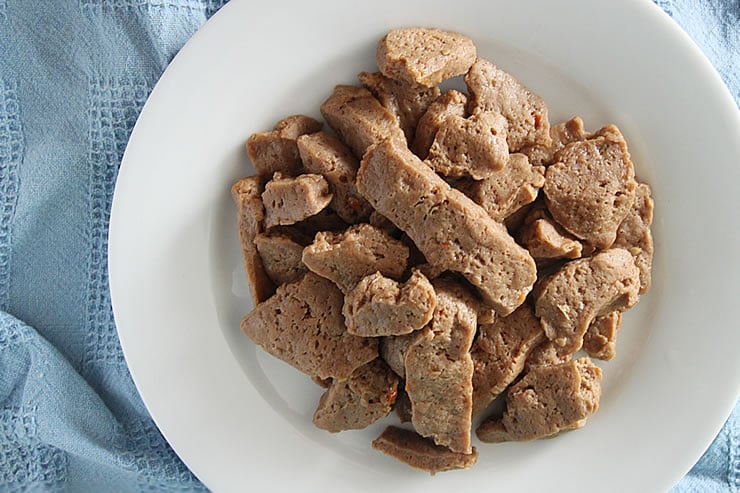
When I stopped eating meat about fifteen years ago I relied, like many new vegetarians, on processed meat substitutes: frozen soy burgers, fake “riblets,” and “chik” nuggets in brightly colored packages. For many people these products ease the transition to a new way of eating, but using them can also become an additive-laden crutch. Over the years I’ve transformed my own diet and, I have abandoned the freezer section for the kitchen with delicious, simple, unprocessed results.
The meat substitute I make most often is a batch of spicy black bean burgers, so tasty my omnivorous husband requests them regularly. But he also enjoys (and has even made) seitan.
Seitan. Mock duck. Wheat meat. Whatever you call it, seitan originated in Asia where vegetarian Buddhists used it in place of meat for centuries. Its spread in popularity is credited to the macrobiotic food movement which began in Japan. The word is not actually Japanese, but based in it, which is why I pronounce it “say-TAHN,” not “Satan.”
What is seitan?
Seitan is simply wheat gluten, spiced and simmered. My previous method used store-bought vital wheat gluten as a shortcut, but Andrew learned that the process to make vital wheat gluten is not replicable at home. Undeterred and not without a little spite, I set out to make it from scratch: Flour and water, here I come! After reading mopey stories about how time-consuming the process was, I was pleasantly surprised that the actual hands-on time was little more than the “shortcut” method, and I enjoyed the end product more than previous batches.
Gluten is the protein found in wheat which, when mixed with water, forms into long stretchy strings that give bread its structure. When you develop those strands, rinse off the starch, and cook the gluten bits, you get seitan. The chewy texture is quite similar to meat — I’ve definitely had seitan-based dishes that I’ve had to double-check that they were actually meat-free.
How to make seitan at home from whole wheat flour
The process is simple, but does take some time. Make a large batch and freeze the extra.
Mix whole wheat flour and water into a stiff dough to develop the gluten. I used my stand mixer.
Cover with cold water and let soak for a few hours or overnight. This both allows the gluten to develop and the starch to “loosen up.”
Knead the dough and rinse with cold water until the water runs clear. It takes about 10 minutes. I used a mesh sieve to help.
You’ll be left with only the gluten, which is considerably smaller in volume than your starting mass of flour. This was a smaller batch than the recipe lists, and 12 ounces of flour yielded just over 5 ounces of seitan.
Those stringy strands are exactly what we want.
Form the gluten into a ball; squeeze out as much water and air as possible. The smaller you can shape the piece of gluten, the firmer texture your finished seitan will have. Cut the gluten into pieces using a bench scraper or sharp knife.
Bring a pot of broth to a boil and drop in the pieces of gluten. Simmer the gluten for about half an hour until the broth is almost gone.
I like to sauté my seitan before using it, or you can store it refrigerated, covered in the broth (add more water if needed) for about a week.
This is a very basic recipe, but you can add spices to the dough when mixing, or play with your broth ingredients to add flavor components at any stage.
My favorite ways to eat seitan are on BBQ mock duck pizza, curried mock duck banh mi, in stir fries and fajitas. Leave the packaged “strips” on the shelf and with just a little effort, make your own unprocessed seitan.
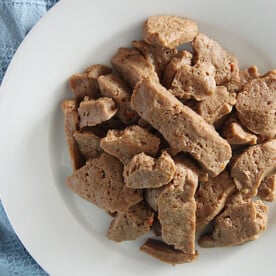
Homemade Seitan from Whole Wheat Flour
This is a very basic recipe. Add spices to the flour before mixing, or change-up the broth for different flavors. You can use homemade or store-bought vegetable stock, or mix up the quick broth outlined below.
Ingredients
Dough
- 6 cups whole wheat flour, 24 ounces / 900 grams
- 2 cups cold water
Broth
- 4 cups water
- 1/4 cup soy sauce, or Braggs liquid aminos
- 1/2 onion, chopped
- 1 tablespoon miso paste
- 1 medium tomato, cut in quarters
- 2 cloves garlic
Instructions
- Combine flour and water. Mix until a stiff-but-cohesive dough is formed. Use a dough hook and a stand mixer if possible.
- Form dough into a ball, place in a bowl, and cover with cold water. Cover and let stand 4-8 hours.
- Knead the dough and rinse until water runs clear, about 10 minutes. Squeeze dough and press out as much liquid and air as possible. Use a sharp knife or a bench scraper to cut the gluten into bite-sized pieces.
- Combine ingredients for broth (or use your preferred vegetable stock) and bring to a boil. Drop gluten pieces into boiling broth and return to a boil. Reduce heat to a simmer. Cook, turning gluten pieces occasionally, until the broth is mostly absorbed and reduced, about 30 minutes. Discard onion and tomato pieces.
- To use seitan right away, drain and sauté in a little oil. To store, cover with broth and keep refrigerated up to a week, or frozen. Thicken and reduce broth as a gravy if desired.
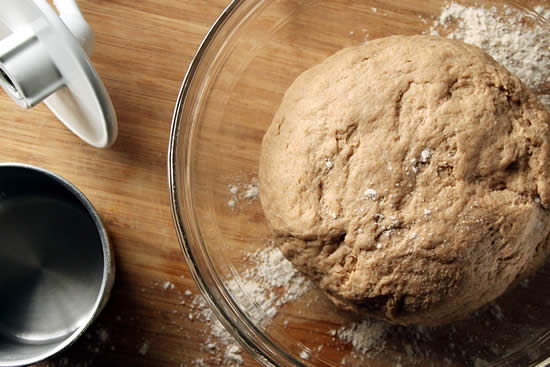
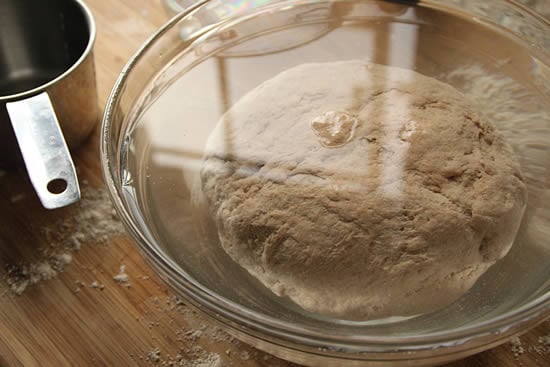

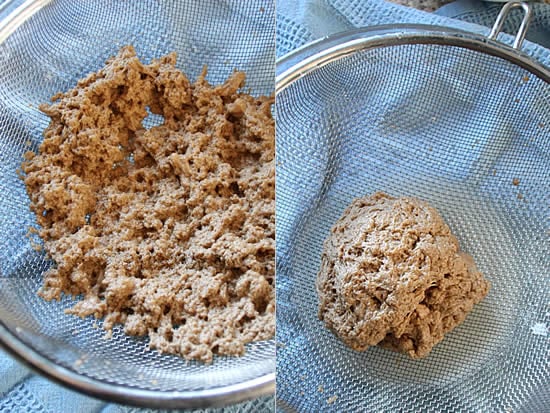
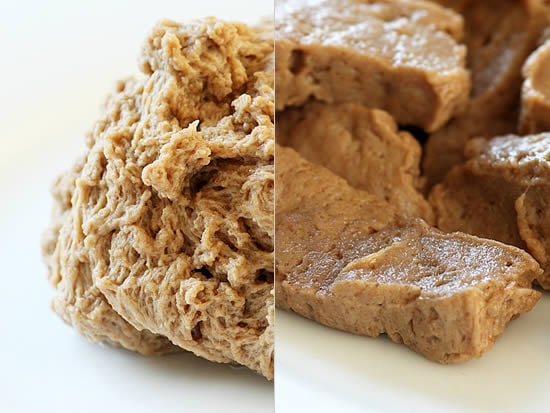
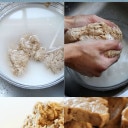

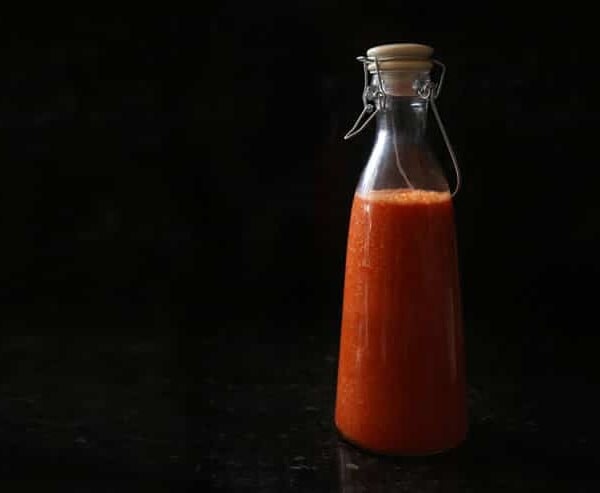

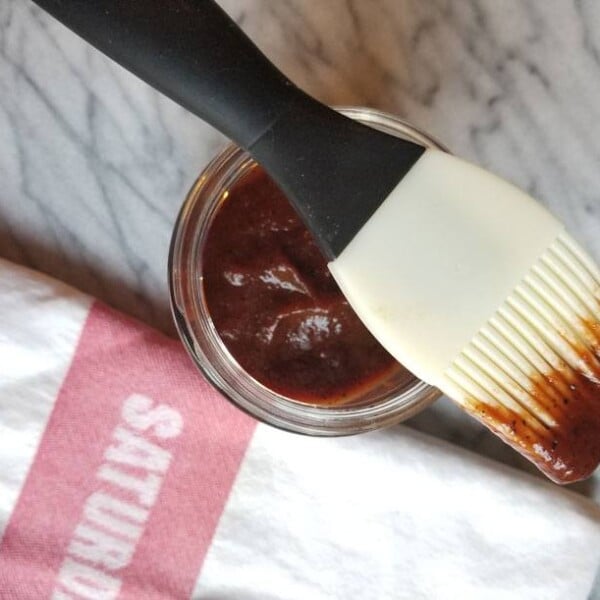
















Just made this today, never had seitan before, I just boiled it in low sodium broth, what is it suppose to taste like? Anyone please 🙂
Seitan when executed correctly has the texture of chicken thigh. So, what you include in the dough and stock flavors it. Check the net for “how to” seasoning recipes, and create what you enjoy.
The flavor of truly homemade seitan (from flour)is so much better than using vital wheat gluten. And you can use a food processor for the kneading portion to cut down on some of the labor!
how do U use the food processor for the kneading?
Use a dough hook
Hey there. Would it be possible to make spelt seitan!
Hi Brian,
While spelt does contain gluten, it’s not a lot and it’s sometimes described as “fragile.” So while it may be possible, you may get very little yield for your efforts. Since you’re trying to get rid of everything but the gluten, it makes a bit more sense to me to start with a higher-gluten-content flour.
But report back if you try it!
I’ve used spelt and it works great!! I’ve also used kamut. And of course whole wheat. I couldn’t tell one was better or worse than the other.
What would happen if I replaced the flour with corn meal?
Hi Erin,
Corn meal doesn’t have any gluten in it, so you wouldn’t develop the stringy protein needed to bring the dough together.
I would recommend using corn meal to make polenta, then cooling it, cutting it up, and grilling or pan-frying it as a base for sauces and veggies. =)
My boyfriend and I made this today. (He did dishes and helped squeeze.) It was very good! I made my own lazy broth lol A1 Steak Sauce in water. I followed the instructions for making the seitan. After it was done I dredged it in my usual rub(sugar, cumin, chile powder, etc) and cooked it in a nonstick skillet in a little oil. It glazed up like bbq sauce and was fabulous with potato salad. I’ve made seitan-ish meatloaf with vital wheat gluten, pureed beans and besan. So I ‘get’ that it’s easier. But this was pretty darn easy too. It was way more economical too! And I got some exercise too! This method/food is a keeper. Thanks for showing me how!
Awesome, Mary! So glad you enjoyed it. =)
Thanks to my fb friend in U.K. My curiosity has got me on a path, I didnt know I may be going. for my health, for my self, for Sprituality. Thank you for your healthy, political and interesingly healthy web page!! Blessings, cheers, Freedom Diana
Hi Stacy…Thanks for this…I guess I’ll have to give it a couple of shots before I come close to perfecting it but it does sound great way to help incorporate more protien in my breakfast 🙂
I Have been making meat substitutes using Tapioca, Sodium alginate, corn masa and texturised soy protein with excellent results except I want to make the Sting cheese fiber texture before adding any major flavors.
Your prompt response is appreciated
Archie Rae McFarland senior wellness science and professional food technologist
You can circumvent a lot of this process and buy gluten flour. Just add water and spices and you are away! Takes about two minutes to prepare and about 1/2 hour to simmer.
Hey Justin, thanks for commenting. As I mentioned in the post, “My previous method used store-bought vital wheat gluten as a shortcut, but Andrew learned that the process to make vital wheat gluten is not replicable at home.” For October Unprocessed the goal was to make seitan from just flour and water (and spices, of course) so that it passes the Kitchen Test.
Thanks for this easy recipe. Seitan is no longer a mystery. I also appreciate the hint about adding spices after the rinsing process. I now feel like I can make anything I want. My first batch turned out like dumplings. Apparently I didn’t rinse enough of the starch out. Thank goodness flour isn’t very expensive.
You’re welcome, Aaron. Sorry the first batch wasn’t quite there, but I have my fingers crossed for round 2! =)